This post may contain affiliate links. For more information, please see our affiliate policy.
Learn how to roast peppers and chilies in the oven or on a gas burner. Use this method for bell peppers, poblanos, serranos, jalapeños, and more!
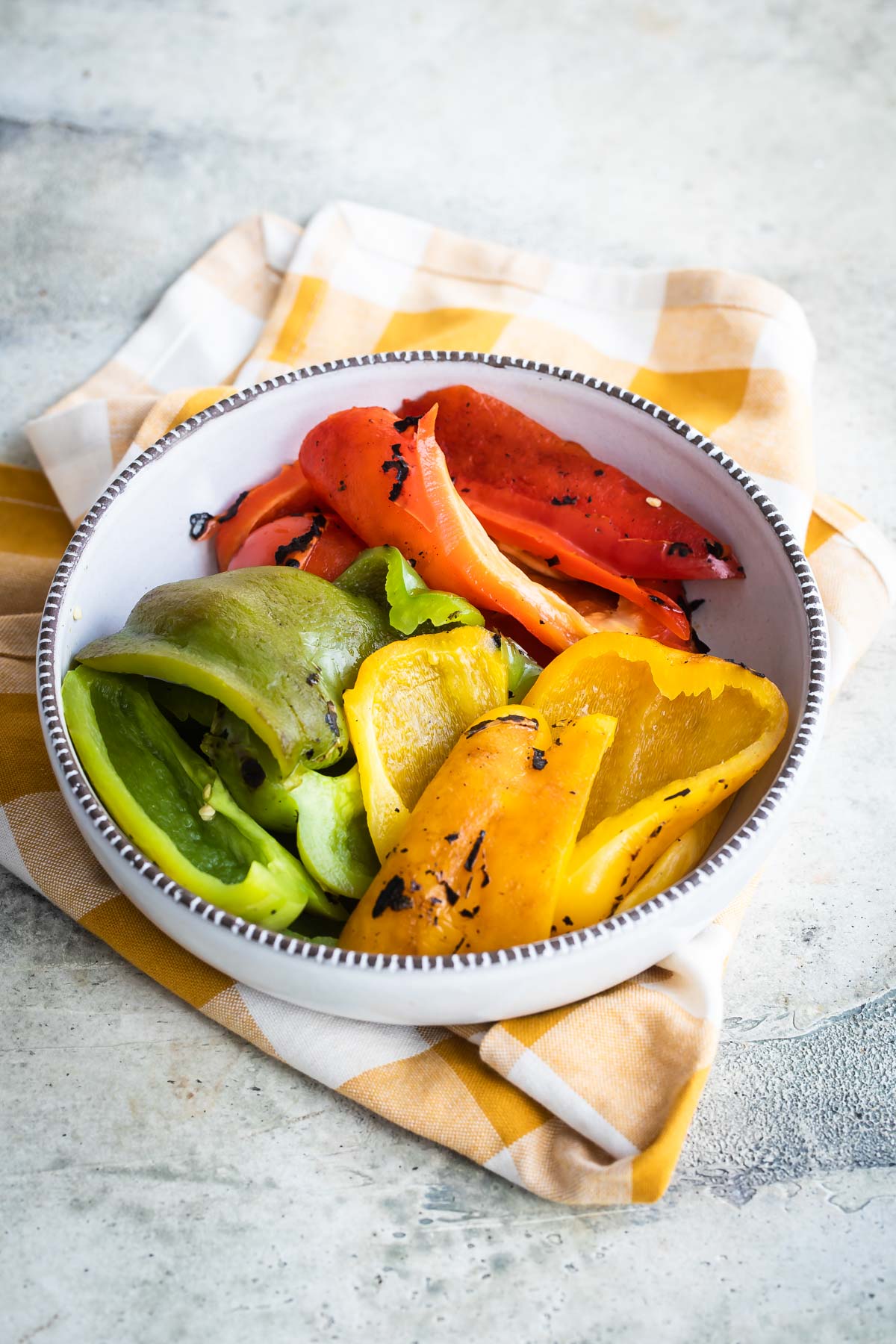
Roasted peppers are an essential element of Mexican cuisine. Over red-hot coals, poblano peppers are turned into tender strips of mixed peppers called Rajas, eaten with queso, and tucked into gorditas, tacos, and tortillas. Spicier chilies are tamed on the fire and added to salsas and sauces, every one more delicious than the next.
Roasting peppers brings out their natural sugars, and makes them supple and downright irresistible in my eyes. I’ll show you how to roast peppers over a direct flame (on the stove or outside, right over the coals on the grill) and even in the oven.
Table of Contents
Ingredient notes
- Peppers vs. chiles: They are the same thing; it’s really just a matter of naming conventions. “Chile” is the Spanish word for capsicums such as jalapeños, serranos, habañeros, poblanos, and so on. Americans sometimes spell it “chili” but now we are moving towards “chile” because “chili” is the stew with the meat. We sometimes say “pepper” in the United States because when Columbus arrived, he thought chiles were “peppers” (as in spicy black pepper, a member of the Piper genus). He was wrong. We always use the word “pepper” for non-spicy peppers such as bell peppers. This process for how to roast peppers works for any chile pepper; bell pepper, poblano, jalapeño, or otherwise.
Step-by-step instructions
- Stove top method: Turn the flame of a gas stove to HIGH. Using tongs, place chilies directly in or over the flame until the skin is charred and blistered but not ash white, turning occasionally, about 2 to 3 minutes. Or, roast over a very hot charcoal or gas grill for 3 to 5 minutes.
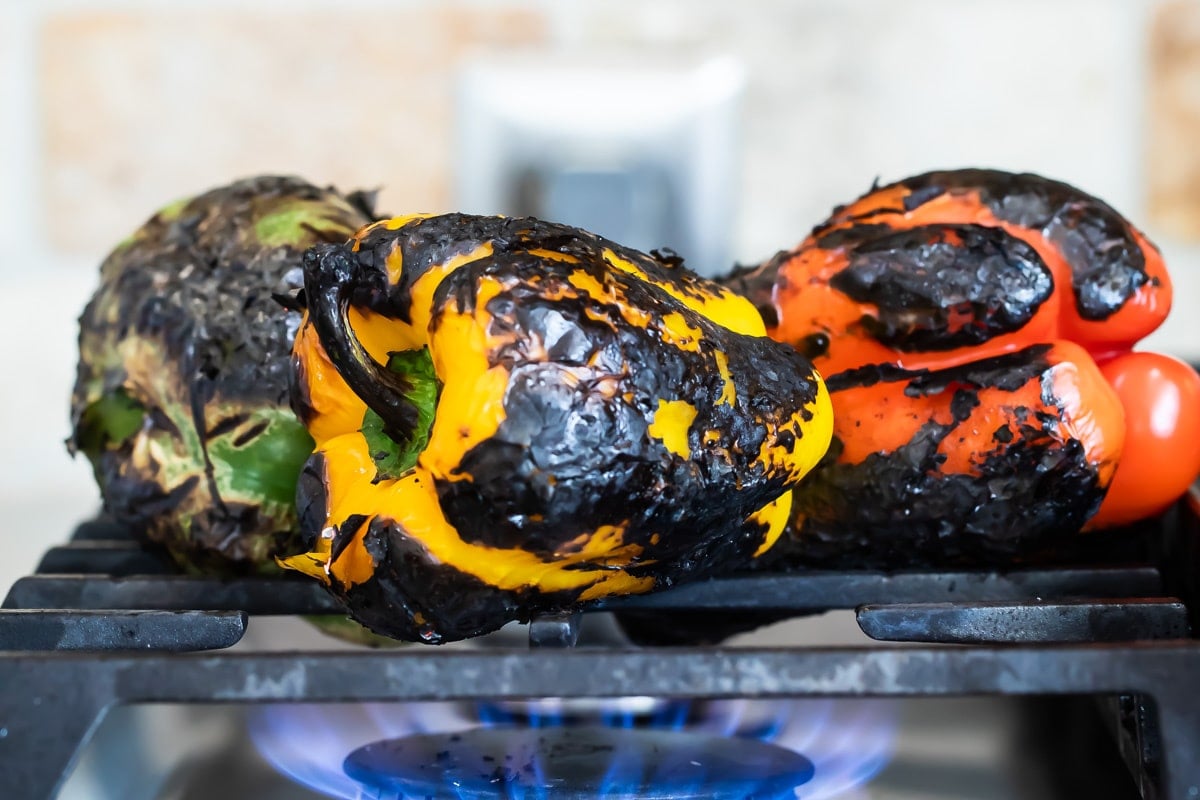
- Broiler method: Arrange an oven rack as close to the broiler element as possible and preheat on HIGH. Line a baking sheet with aluminum foil for easy cleanup. Arrange peppers in a single layer on prepared baking sheet. Broil the peppers until the skin is charred and blistered but not ash white, turning often, about 5 to 10 minutes.
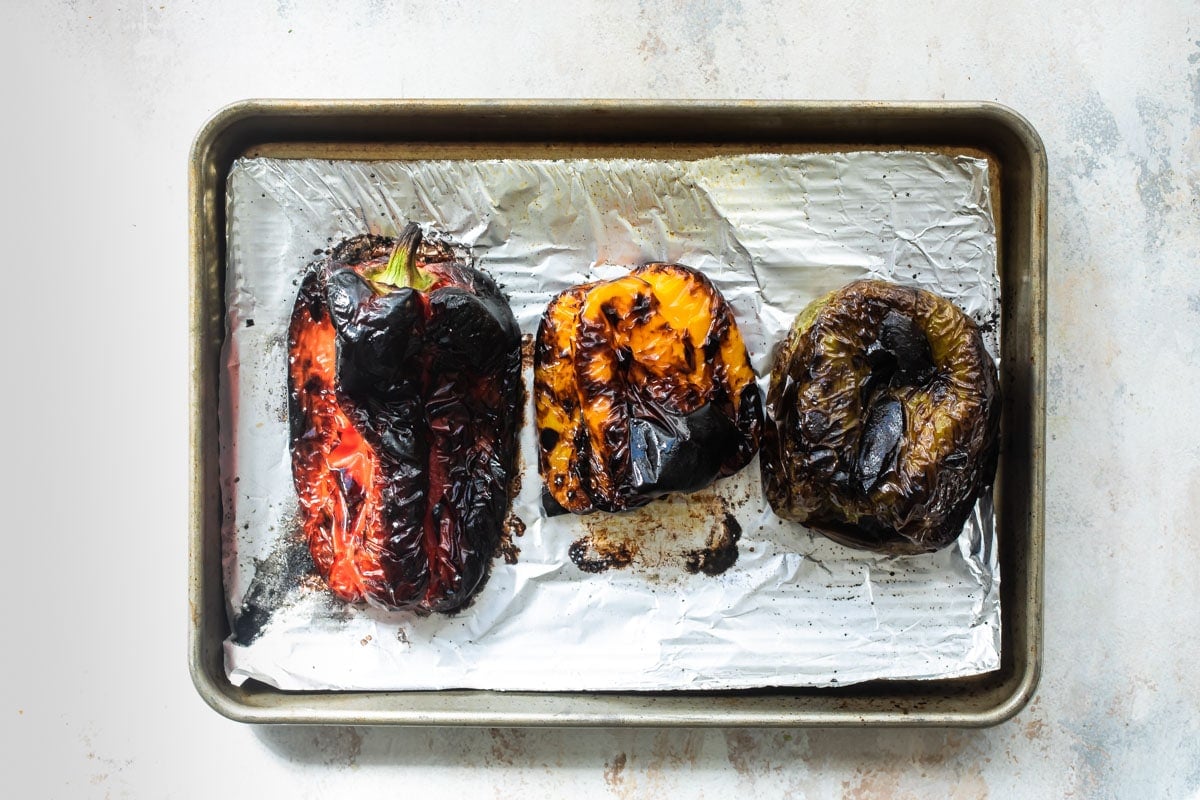
- Oven method: Preheat oven to 400 degrees. Line a baking sheet with aluminum foil for easy cleanup. Arrange peppers in a single layer on prepared baking sheet. Broil the peppers until the skin is charred and blistered but not ash white, turning occasionally, about 30 to 40 minutes.
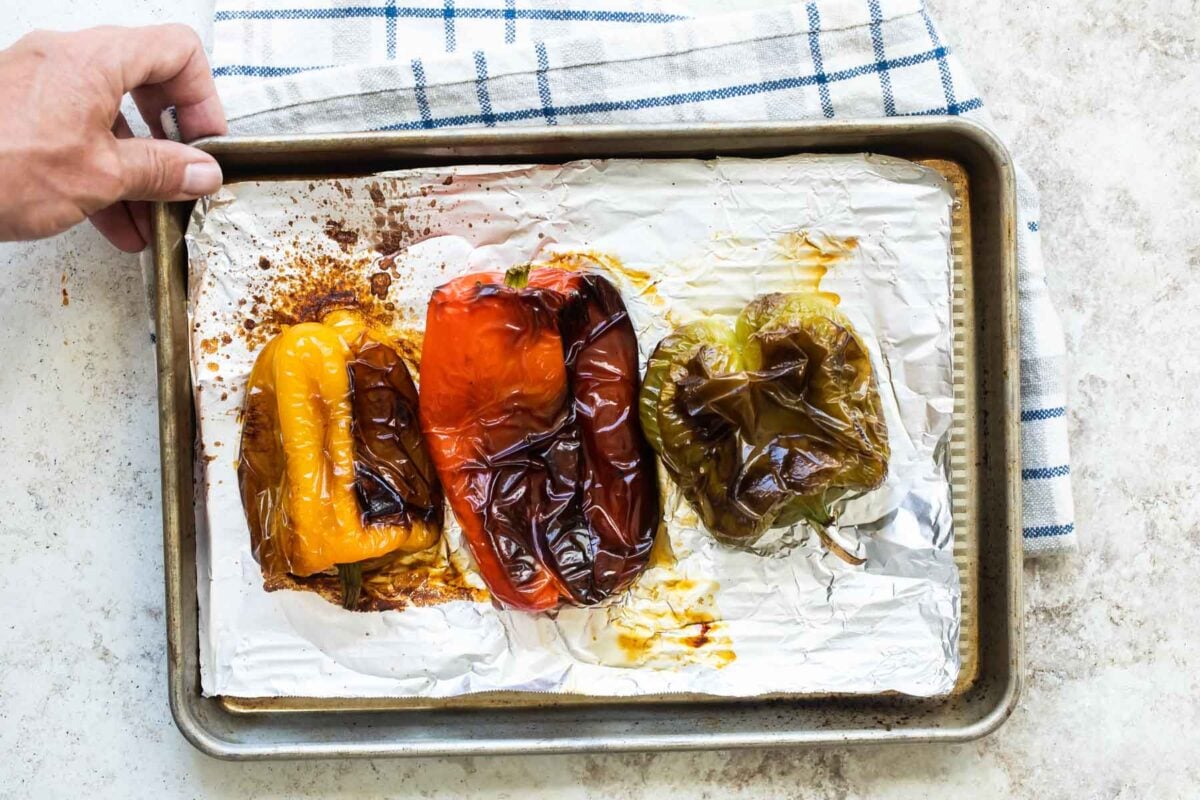
- Transfer to a bowl and cover tightly with plastic wrap. Let stand until the skin starts to loosen and the peppers are cool enough to handle, about 10 minutes.
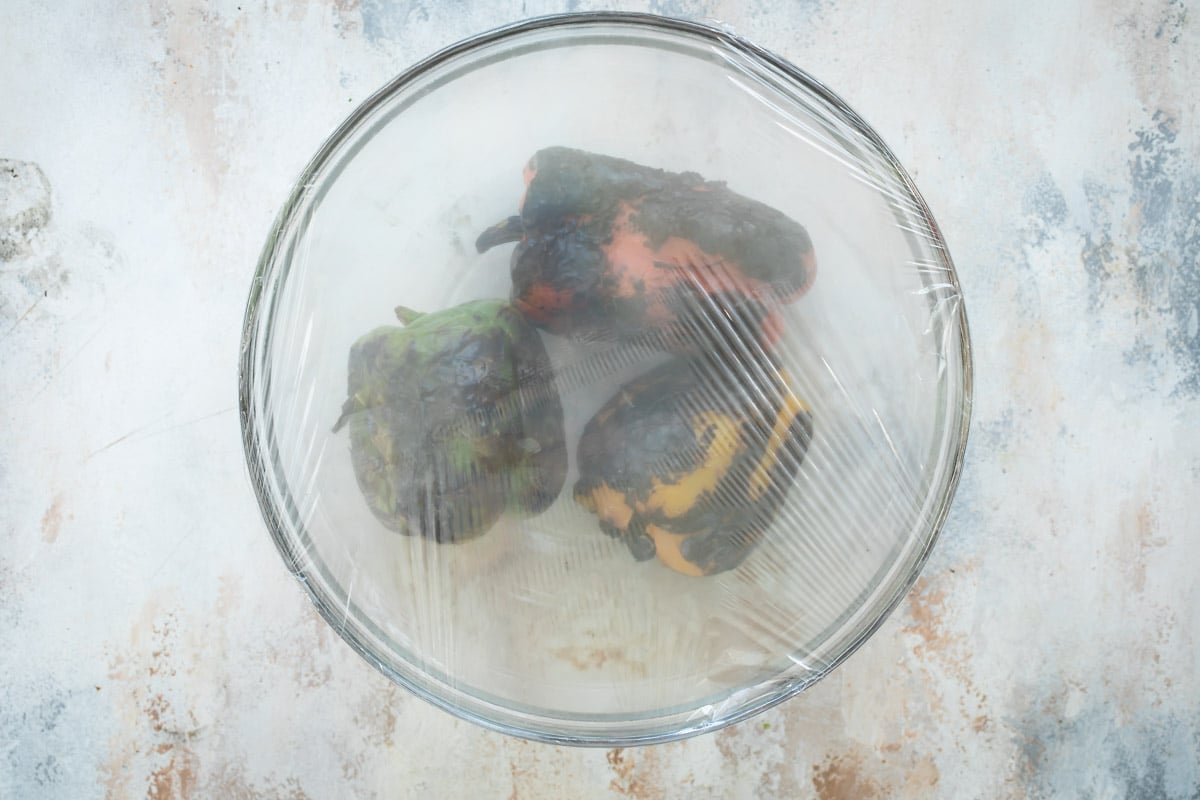
- Wearing gloves or using a clean kitchen towel, carefully rub off and discard the blackened skin. Leave the stem and seeds intact if desired for your recipe; otherwise, remove and discard them.
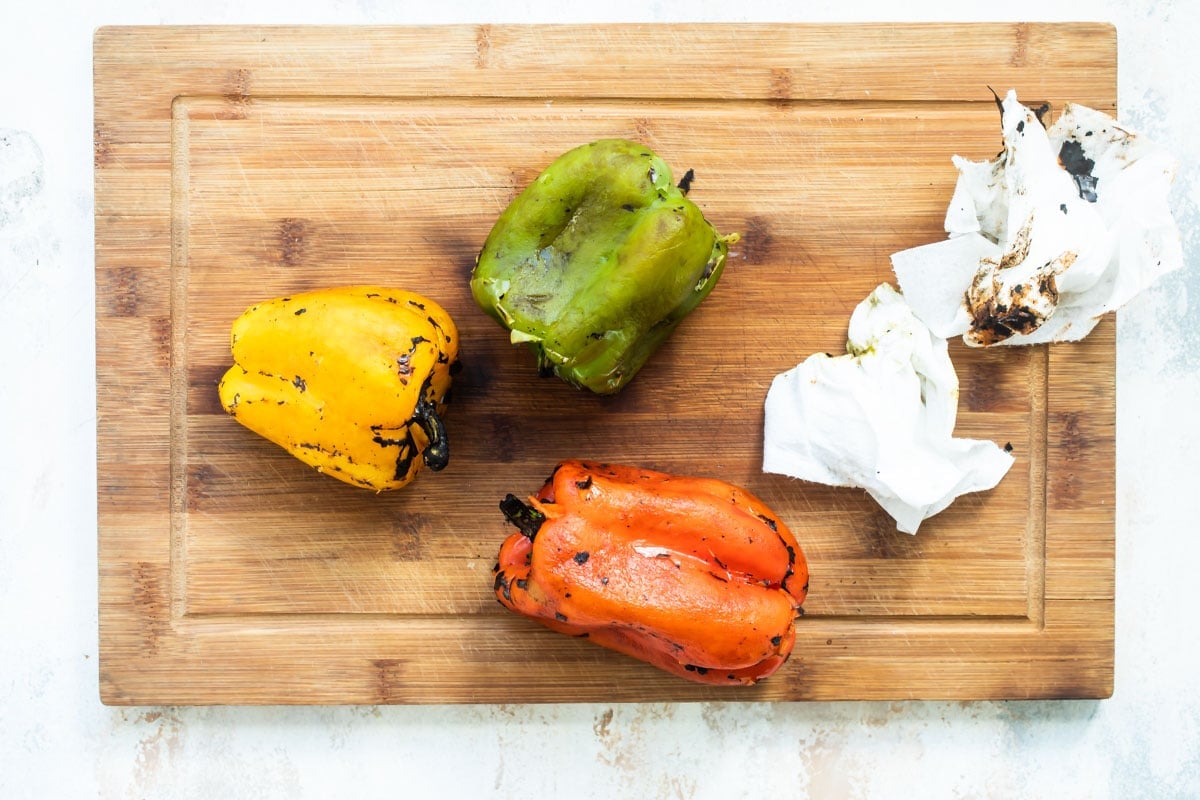
- To seed the peppers for stuffing: Using a small knife, slit each pepper lengthwise from the stem to the bottom, leaving the top 1/2-inch and the bottom 1/2-inch uncut. Leaving the stem intact, remove seeds and membranes. Wipe inside of pepper with a damp towel and dry well.
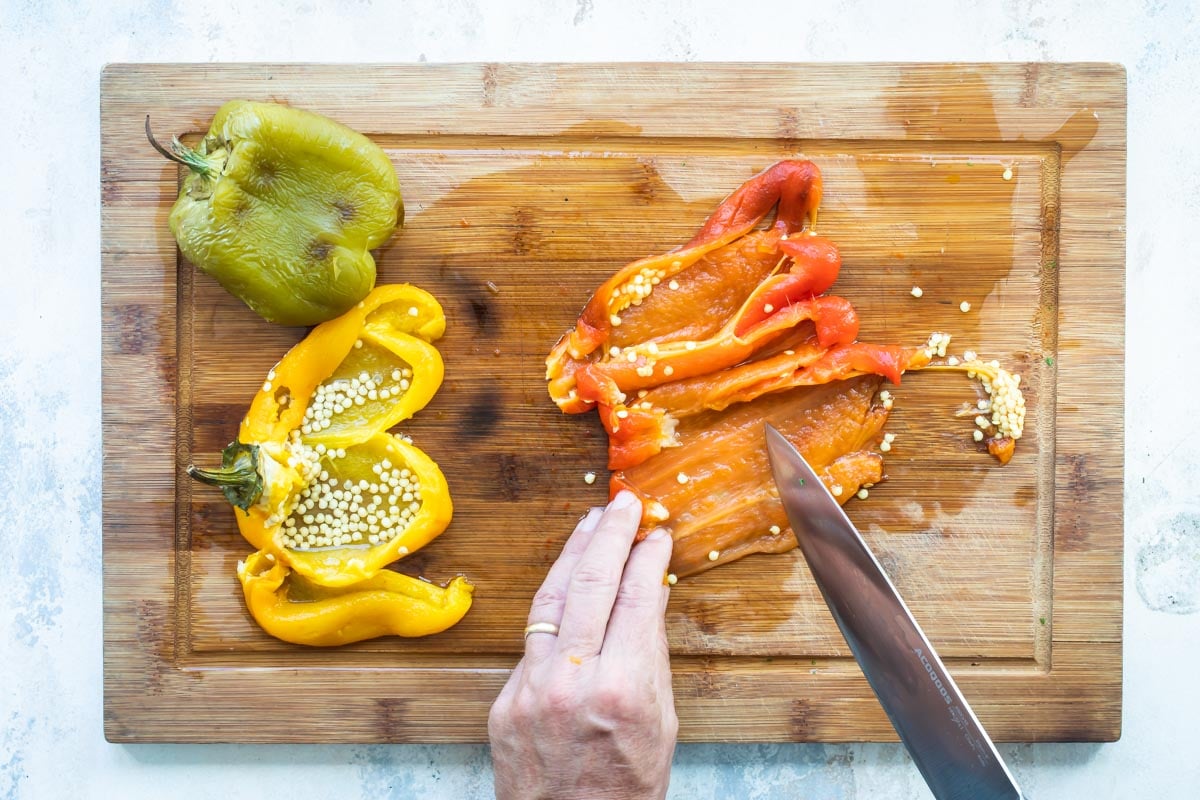
- To slice or chop the peppers: Slit each pepper lengthwise and lay flat. Cut out stem, remove seeds and membranes, and slice or chop as desired.
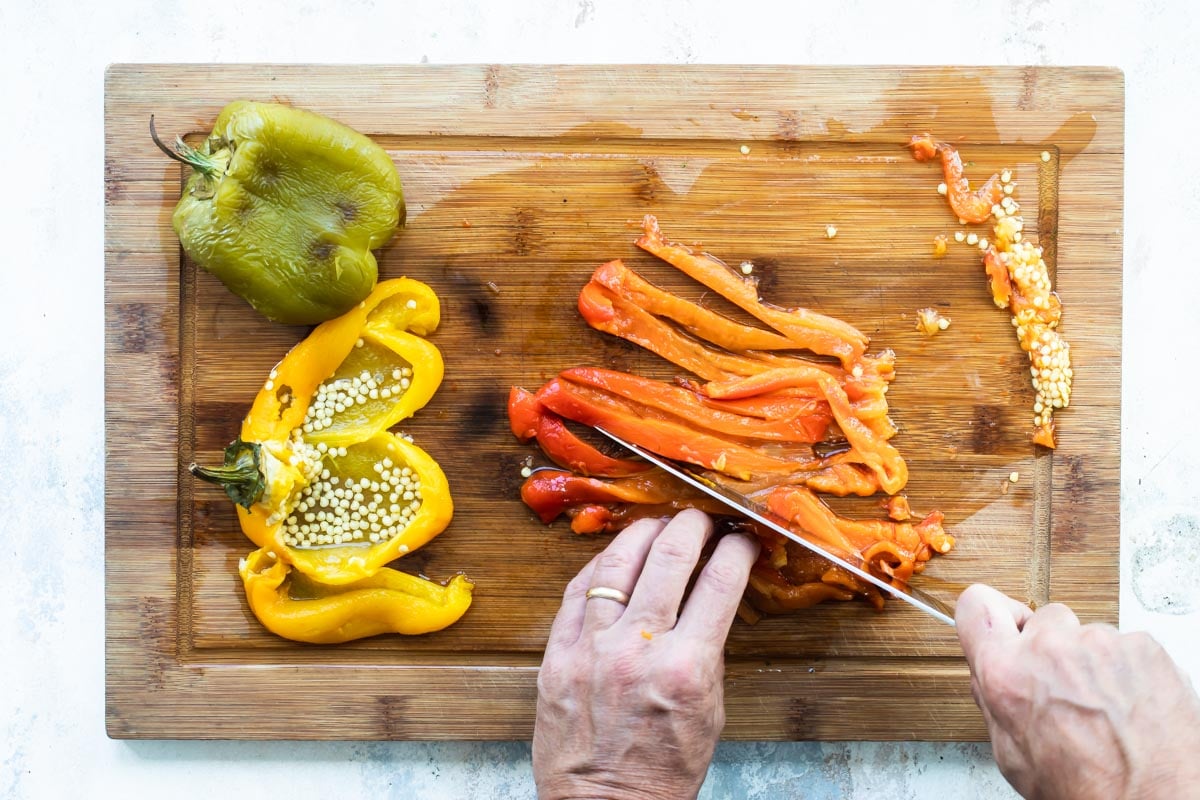
Recipe tips and variations
- Yield: This method results in 1 pound of roasted peppers, but can easily be scaled up or down as desired.
- Storage: Transfer roasted peppers to a covered container and refrigerate for up to a week. Or, store them in the freezer for up to 3 months. Canned roasted peppers? Even longer.
- Freezer: Cool roasted, peeled peppers completely. Transfer to a freezer-safe container, label, date, and freeze up to 3 months. Thaw overnight in the refrigerator.
- Steam those skins: Wrapping in plastic wrap (or a zip-top plastic bag also works!) is a crucial step after roasting peppers. It makes the pepper’s papery, tough outer skin loosen and separate from the rest of the vegetable. And that makes it easier to remove! If the skin doesn’t fall off easily, grab a clean kitchen towel or some dry paper towels and rub with those.
- Rock a pair of gloves: I definitely recommend wearing gloves (heat-resistant cooking gloves are perfect for roasting and peeling, although disposable gloves can work for the peeling process). Some peppers are spicy no matter what, and I always seem to have an itch near my eye when I handle peppers without gloves. I’ve paid the price more than once, and don’t want you to make the same mistake.
- To seed or not to seed? Once the peppers are finished, you can leave them as-is, with seeds inside, or remove the seeds. Read your recipe to see what it calls for. Depending on what you’re cooking, keep them whole for stuffed peppers, or stem, seed, and chop and add them to soups, salads, sandwiches, and the most phenomenal salsa recipe ever!
- Aim for blackened peppers, not ash: Try not to roast the peppers so long that they begin to shoulder into ash. The stem may burn like a match, and that’s okay, but you want to preserve the sweet flesh of the pepper under that blistered skin.
- Cooking times may vary: Watch the peppers closely as they roast. Different-sized peppers will need more or less cooking time than what is specified in this guide for how to roast peppers. You’ll get the hang of it!
- DIY diced green chilies. Roasted, peeled, and diced jalapeño peppers can be used in any recipe calling for a can of “diced green chiles.”
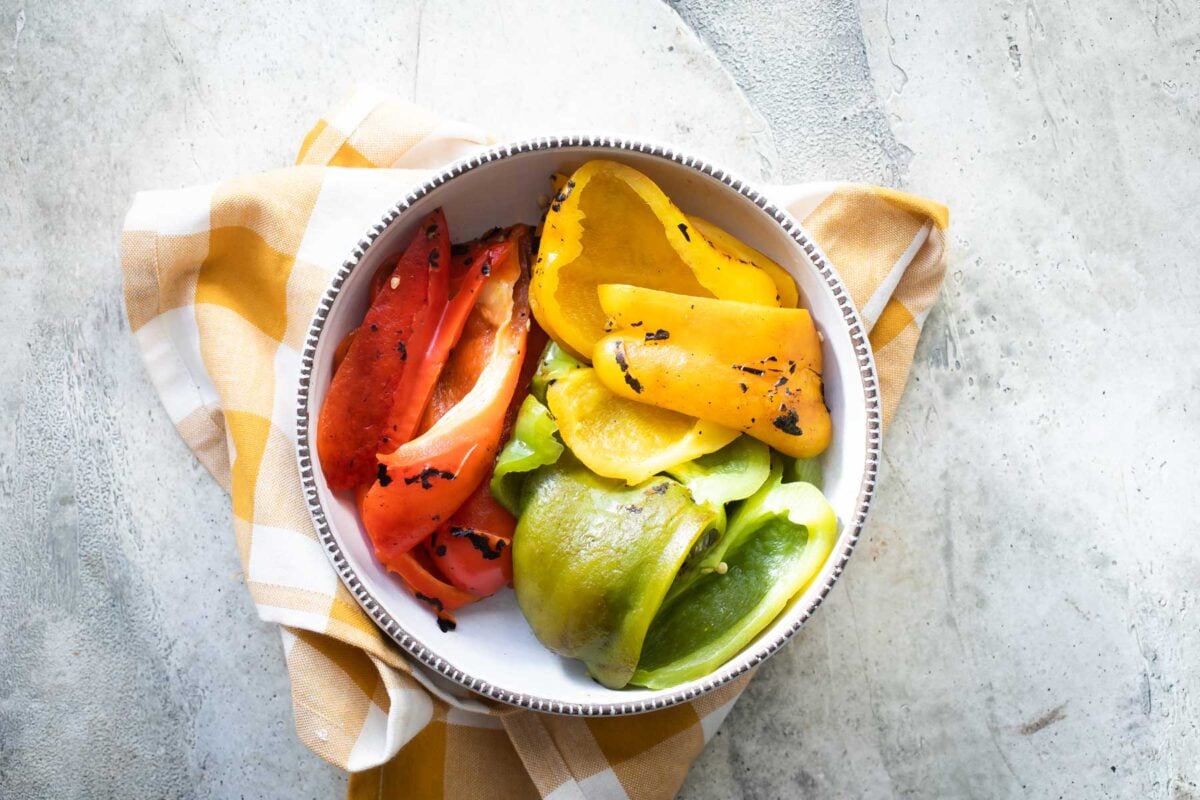
Recipe FAQs
Roasting any vegetable, including bell peppers and chiles, enhances their flavor and adds a rich smokiness.
Roasting makes the skin easy to remove, but it is not always necessary to actually do that. However, peeling the peppers improves the texture (depending on who you ask). The classic Mexican dish rajas, roasted poblano chiles, requires that they are peeled.
Chile Relleno
My favorite recipe for Chile Relleno features roasted Poblano chiles stuffed with two kinds of cheese, then beer-battered and fried to crispy-on-the-outside, gooey-on-the-inside perfection. It’s definitely worth the extra effort. In 2004, I tried Chiles Rellenos…
View RecipeMore Mexican cuisine favorites
Mexican Recipes
Mexican Rice
Mexican Recipes
Chicken Tinga
Mexican Recipes
Carne Asada
Chipotle Copycat Recipes
Chipotle Corn Salsa (Copycat)
Join Us
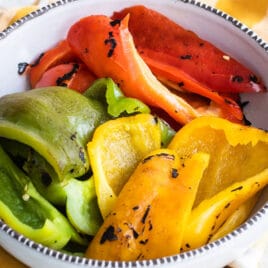
How to Roast Peppers
Ingredients
- 1 pound bell peppers or chilies (see note 1)
Instructions
Stovetop method:
- Turn the flame of a gas stove to HIGH. Using tongs, place chilies directly in or over the flame until the skin is charred and blistered but not ash white, turning occasionally, about 2 to 3 minutes. Or, roast over a very hot charcoal or gas grill for 3 to 5 minutes.
- Transfer to a bowl and cover tightly with plastic wrap. Let stand until the skin starts to loosen and the peppers are cool enough to handle, about 10 minutes.
- Wearing gloves or using a clean kitchen towel, carefully rub off and discard the blackened skin. Leave the stem and seeds intact if desired for your recipe; otherwise, remove and discard them.
Broiler method:
- Arrange an oven rack as close to the broiler element as possible and preheat on HIGH. Line a baking sheet with aluminum foil for easy cleanup. Arrange peppers in a single layer on prepared baking sheet.
- Broil the peppers until the skin is charred and blistered but not ash white, turning often, about 5 to 10 minutes.
- Transfer to a bowl and cover tightly with plastic wrap. Let stand until the skin starts to loosen and the peppers are cool enough to handle, about 10 minutes.
- Wearing gloves or using a clean kitchen towel, carefully rub off and discard the blackened skin. Leave the stem and seeds intact if desired for your recipe; otherwise, remove and discard them.
Oven method:
- Preheat oven to 400 degrees. Line a baking sheet with aluminum foil for easy cleanup. Arrange peppers in a single layer on prepared baking sheet.
- Broil the peppers until the skin is charred and blistered but not ash white, turning occasionally, about 30 to 40 minutes.
- Transfer to a bowl and cover tightly with plastic wrap. Let stand until the skin starts to loosen and the peppers are cool enough to handle, about 10 minutes.
- Wearing gloves or using a clean kitchen towel, carefully rub off and discard the blackened skin. Leave the stem and seeds intact if desired for your recipe; otherwise, remove and discard them.
To seed the peppers for stuffing:
- Using a small knife, slit each pepper lengthwise from the stem to the bottom, leaving the top 1/2-inch and the bottom 1/2-inch uncut. Leaving the stem intact, remove seeds and membranes. Wipe inside of pepper with a damp towel and dry well.
To slice or chop the peppers:
- Slit each pepper lengthwise and lay flat. Cut out stem, remove seeds and membranes, and slice or chop as desired.
Recipe Video
Notes
- Peppers vs. chiles: They are the same thing; it’s really just a matter of naming conventions. “Chile” is the Spanish word for capsicums such as jalapeños, serranos, habañeros, poblanos, and so on. Americans sometimes spell it “chili” but now we are moving towards “chile” because “chili” is the stew with the meat. We sometimes say “pepper” in the United States because when Columbus arrived, he thought chiles were “peppers” (as in spicy black pepper, a member of the Piper genus). He was wrong. We always use the word “pepper” for non-spicy peppers such as bell peppers. This process for how to roast peppers works for any chile pepper; bell pepper, poblano, jalapeño, or otherwise.
Nutrition
Meggan Hill is a classically-trained chef and professional writer. Her meticulously-tested recipes and detailed tutorials bring confidence and success to home cooks everywhere. Meggan has been featured on NPR, HuffPost, FoxNews, LA Times, and more.
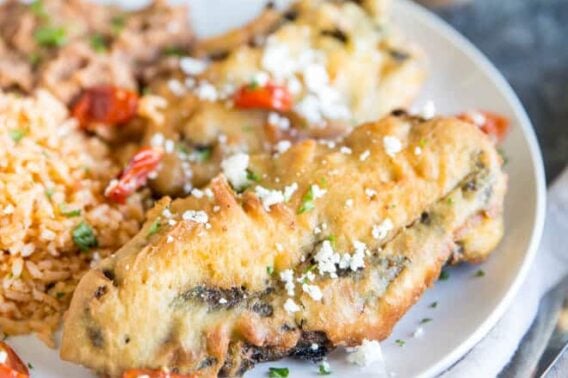
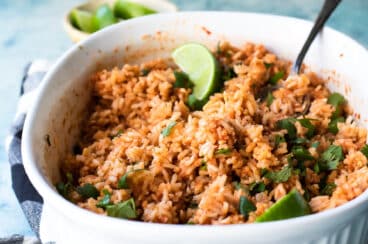
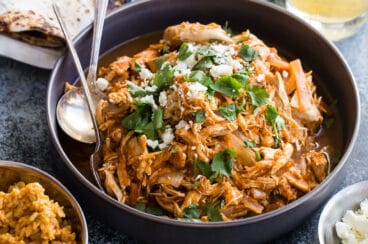
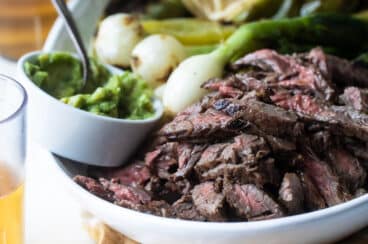
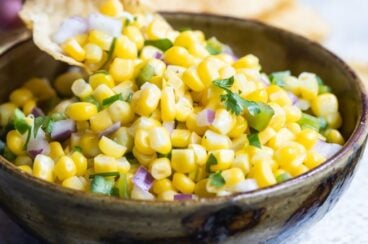
I just tried the oven method of roasting the peppers from my garden and they exploded all over the oven.
Hi Teresa! Oh no! That sounds awful! I wonder if they were not turned often enough, and were too hot on the side facing the broiler. Sorry they exploded. – Meggan
Thank you very much for telling me how to roast these peppers that someone gave to me. I know what to do with bell peppers, but I didn’t know what to do with these peppers. They look like a bell pepper at the top but they have a long stem in the shape of a pepper. What do you stuff them with.? Are they hot like Mexican food which we eat a lot in Texas where I am. Thank you very much Marilyn Cope, Dallas, Texas
Hi Marilyn, I’m not sure what kind of pepper exactly they could be. There are so many varieties! I would suggest you do a Google search to see if you’re able to find one that looks like the type your neighbor has given you. Depending on the type, they could range from mild to very, very spicy! You likely will be able to stuff them with cheese, or even a meat mixture, depending on the type. Sorry I couldn’t be more help! – Meggan
How long do these keep in fridge? Can they be frozen? If so, should they be thawed before using?
So sorry; I just saw answers to my questions in your posting!